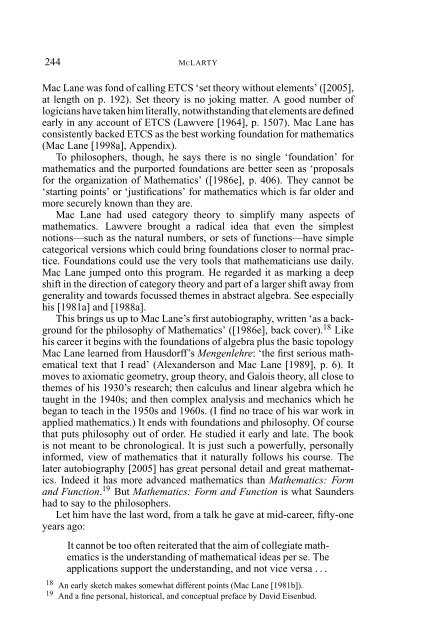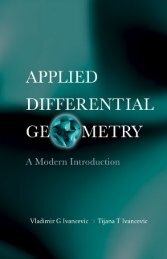PMeulogt MacLane
PMeulogt MacLane
PMeulogt MacLane
Create successful ePaper yourself
Turn your PDF publications into a flip-book with our unique Google optimized e-Paper software.
244 MCLARTY<br />
Mac Lane was fond of calling ETCS ‘set theory without elements’ ([2005],<br />
at length on p. 192). Set theory is no joking matter. A good number of<br />
logicians have taken him literally, notwithstanding that elements are defined<br />
early in any account of ETCS (Lawvere [1964], p. 1507). Mac Lane has<br />
consistently backed ETCS as the best working foundation for mathematics<br />
(Mac Lane [1998a], Appendix).<br />
To philosophers, though, he says there is no single ‘foundation’ for<br />
mathematics and the purported foundations are better seen as ‘proposals<br />
for the organization of Mathematics’ ([1986e], p. 406). They cannot be<br />
‘starting points’ or ‘justifications’ for mathematics which is far older and<br />
more securely known than they are.<br />
Mac Lane had used category theory to simplify many aspects of<br />
mathematics. Lawvere brought a radical idea that even the simplest<br />
notions—such as the natural numbers, or sets of functions—have simple<br />
categorical versions which could bring foundations closer to normal practice.<br />
Foundations could use the very tools that mathematicians use daily.<br />
Mac Lane jumped onto this program. He regarded it as marking a deep<br />
shift in the direction of category theory and part of a larger shift away from<br />
generality and towards focussed themes in abstract algebra. See especially<br />
his [1981a] and [1988a].<br />
This brings us up to Mac Lane’s first autobiography, written ‘as a background<br />
for the philosophy of Mathematics’ ([1986e], back cover). 18 Like<br />
his career it begins with the foundations of algebra plus the basic topology<br />
Mac Lane learned from Hausdorff’s Mengenlehre: ‘the first serious mathematical<br />
text that I read’ (Alexanderson and Mac Lane [1989], p. 6). It<br />
moves to axiomatic geometry, group theory, and Galois theory, all close to<br />
themes of his 1930’s research; then calculus and linear algebra which he<br />
taught in the 1940s; and then complex analysis and mechanics which he<br />
began to teach in the 1950s and 1960s. (I find no trace of his war work in<br />
applied mathematics.) It ends with foundations and philosophy. Of course<br />
that puts philosophy out of order. He studied it early and late. The book<br />
is not meant to be chronological. It is just such a powerfully, personally<br />
informed, view of mathematics that it naturally follows his course. The<br />
later autobiography [2005] has great personal detail and great mathematics.<br />
Indeed it has more advanced mathematics than Mathematics: Form<br />
and Function. 19 But Mathematics: Form and Function is what Saunders<br />
had to say to the philosophers.<br />
Let him have the last word, from a talk he gave at mid-career, fifty-one<br />
years ago:<br />
It cannot be too often reiterated that the aim of collegiate mathematics<br />
is the understanding of mathematical ideas per se. The<br />
applications support the understanding, and not vice versa ...<br />
18 An early sketch makes somewhat different points (Mac Lane [1981b]).<br />
19 And a fine personal, historical, and conceptual preface by David Eisenbud.














